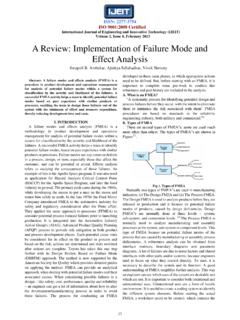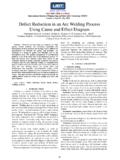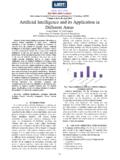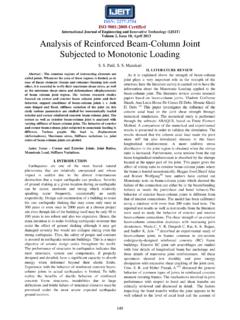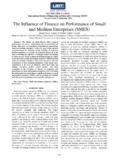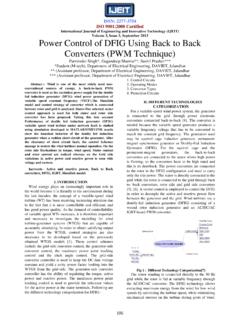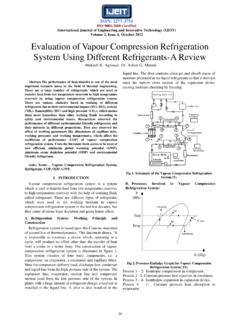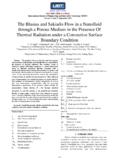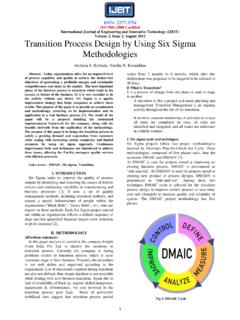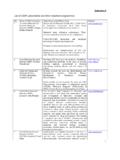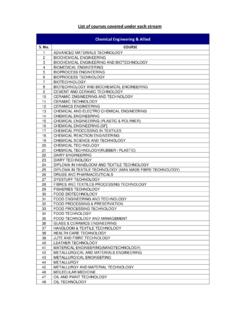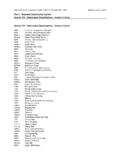Transcription of A Study on Transparent Concrete: A Novel …
1 ISSN: 2277-3754 ISO 9001:2008 Certified International Journal of Engineering and Innovative Technology (IJEIT) Volume 2, Issue 8, February 2013 83 A Study on Transparent concrete : A Novel Architectural Material to Explore Construction Sector Bhavin K. Kashiyani, Varsha Raina, Jayeshkumar Pitroda, Dr. Bhavnaben K. Shah Abstract: Transparent concrete is a concrete based building material with light-Tran missive properties due to embedded light optical elements usually Optical fibres. Light is conducted through the stone from one end to the other. Therefore the fibres have to go through the whole object. Transparent concrete is also known as the translucent concrete and light transmitting concrete because of its properties. It is used in fine architecture as a facade material and for cladding of interior walls.
2 In this paper, to integrate the merits of concrete and optical fiber, for developing Transparent concrete by arranging the high numerical aperture Plastic Optical Fibres (POF) or big diameter glass optical fiber into concrete . The main purpose is to use sunlight as a light source to reduce the power consumption of illumination and to use the optical fiber to sense the stress of structures and also use this concrete as an architectural purpose for good aesthetical view of the building. Keywords: Transparent concrete , Optical Fibre, Architectural, concrete . I. INTRODUCTION Just a few decades ago concrete was often misunderstood, disliked and captured by its image fixed due to the rapid urbanization of the1960s. But since that time, concrete has made considerable progress, not only in technical terms, but also in aesthetic terms.
3 It is no longer the heavy, cold and grey material of the past; it has become beautiful and lively. By research and innovation, newly developed concrete hasbeen created which is more resistant, lighter, white or colored, etc. concrete has learned to adapt to almost all new challenges that appeared. In 2001, the concept of Transparent concrete was first put forward by Hungarian architect AronLosonzi, and the first Transparent concrete block was successfully produced by mixing large amount of glass fiber into concrete in 2003, named as LiTraCon. Joel S. and Sergio developed a Transparent concrete material, which can allow 80% light through and only 30% of weight of common concrete . It is worth mentioning that Italian Pavilion in Shanghai Expo 2010 shows a kind of Transparent concrete developed by mixing glass into concrete in 2010.
4 While the Transparent concrete mainly focuses on transparency and its objective of application pertains to green technology and artistic finish. Therefore it is imperative to develop a new functional material to satisfy the structure in terms of safety monitoring (such as damage detection, fire warning), environmental protection and energy saving and artistic modeling. Transparent or translucent concrete can be seen as a recent answer to the architects call for more Transparent Architecture. Table 1 Properties of Transparent concrete Blocks By Litracon Company Product Litracon- Light Transmitting concrete Form Prefabricated blocks Ingredients 96% concrete , 4% optical fibre Density 2100-2400 Kg/m2 Block size 600mm x 300mm Thickness 25-500mm Colour White, Grey or Black Fibre distribution Organic Finished Polished Compressive strength 50 N/mm2 Bending Tensile strength 7 N/mm2 Source: II.
5 MATERIAL USED FOR Transparent concrete There are two basic materials used for making Transparent concrete , one is from construction field and another from sensing field. First, concrete is one of the most important civil engineering materials with the advantages of rich raw materials, low cost and simple production process and second the optical fiber has good light guiding property which can be arrange to transmit the light and the sun light transmit according to pre-design road without light-heat, light-electrical or photochemical process, and photo elastic effect which can be used to Study the stress distribution of structures. Combining the advantages of the concrete and optical fiber, developing a Novel functional material called Transparent concrete has an important value in the application of construction and sensing.
6 Types of optical fibre There are three basic types of optical fibers: [1] Multimode graded-index fiber [2] Multimode step-index fiber [3] Single-mode step-index fibers. A multimode fiber can propagate hundreds of light modes at one time while single-mode fibers only propagate one mode as shown below. ISSN: 2277-3754 ISO 9001:2008 Certified International Journal of Engineering and Innovative Technology (IJEIT) Volume 2, Issue 8, February 2013 84 Fig 1: Types of Fibre Source: Simon Kwan, Principles of Optical Fibers , San Jose State University, 2002 Since the single-mode fibers propagate light in one clearly defined path, intermodal dispersion effects is not present, allowing the fiber to operate at larger bandwidths than a multimode fiber. On the other hand, multimode fibers have large intermodal dispersion effects due to the many light modes of propagations it handles at one time.
7 III. PRINCIPLE Transparent concrete or translucent concrete is work Based on Nano-Optics . Optical fibres passes as much light when tiny slits are placed directly on top of each other as when they are staggered. Principal can carry because optical fibers in the concrete act like the slits and carry the light across throughout the concrete . Fig 2: Transparent Panels Source: IV. CONSTRUCTION Transparent concrete is produced out of fine-grain con-crete and translucent fabric which is layer cast in pre-fabricated mould. Because of relatively small amount of fabric, solidity and consistency of Transparent concrete are the same as the high-strength concrete . Almost free energy loss light penetration through optic fibres makes it possible to see light, shadows and even colours through concrete even by very thick walls.
8 It can be produced as prefabricated building blocks and panels. Due to the small size of the fibres, they blend into concrete becoming a component of the material like small pieces of aggregate. In this manner, the result is not mixed material like glass in concrete but a new material, which is homogeneous in its inner structure as well as on its main surfaces. The optical fibres lead light by points between the two sides of the blocks. Because of their parallel position, the light-information on the brighter side of such a wall appears unchanged on the darker side. The most interesting form of this phenomenon is probably the sharp display of shadows on the opposing side of the wall. Moreover, the colour of the light also remains the same. V. MANUFACTURING PROCESS The manufacturing process of Transparent concrete is almost same as regular concrete .
9 Only optical fibres are spread throughout the aggregate and cement mix. Small layers of the concrete are poured on top of each other and infused with the fibers and are then connected. Thousands of strands of optical fibers are cast into concrete to transmit light, either natural or concrete is produced by adding 4% to 5% optical fibers by volume into the concrete mixture. The concrete mixture is made from fine materials only it does not contain coarse aggregate. Thickness of the optical fibers can be varied between 2 m and 2 mm to suit the particular requirements of light production processes use woven fibres fabric instead of single filaments. Fabric and concrete are alternately inserted into molds at intervals of approximately 2 mm to 5 or thinner layers allow an increased amount of light to pass through the concrete .
10 Following casting, the material is cut into panels or blocks of the specified thickness and the surface is then typically polished, resulting in finishes ranging from semi-gloss to high-gloss. Fig 3: Transparent concrete When Optical Fibres Are In Organic Distribution Source: Victoria Bailey, Translucent concrete , MEEN 3344-001 ISSN: 2277-3754 ISO 9001:2008 Certified International Journal of Engineering and Innovative Technology (IJEIT) Volume 2, Issue 8, February 2013 85 Fig 4: Transparent concrete When Optical Fibres Are In Layered Distribution Source: Victoria Bailey, Translucent concrete , MEEN 3344-001 VI. APPLICATION A. Illuminate Your Walls Transparent concrete can be used as building material for interior and exterior walls. If sunshine illuminates the wall structure, then eastern or western placement is recommended; the rays of the rising or setting sun will hit the optical glass fibers in a lower angle and the intensity of the light will be bigger.
